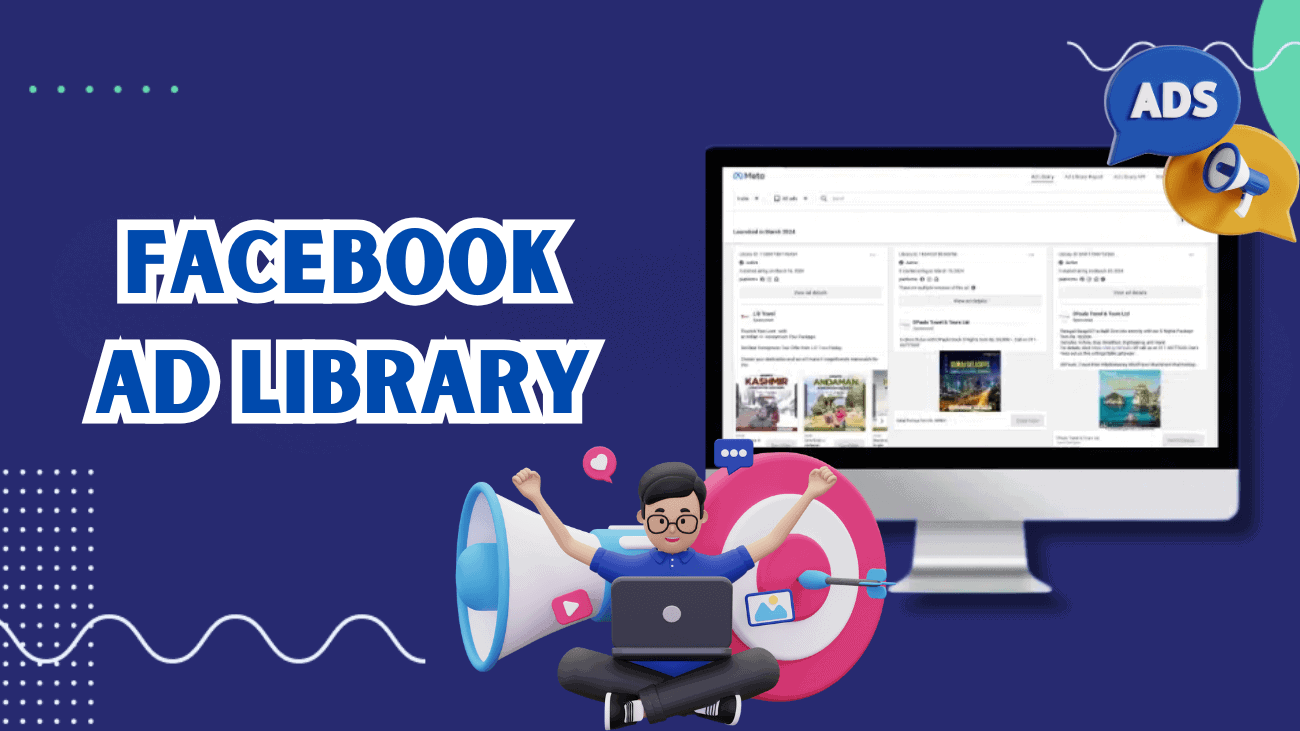Are you looking to improve your advertising campaigns? The Facebook Ad Library is the perfect tool to help you understand what works in digital marketing. This handy resource gives you insights into successful ads, making it essential for anyone who wants to boost their brand’s visibility.
With over 10 million businesses advertising on Facebook and Instagram, it can be tough to stand out. Rising costs and fierce competition mean you need a smart strategy. Luckily, the Facebook Ad Library allows you to see what your competitors are doing. By checking out the ads they run, you can find inspiration for your own campaigns.
Whether you’re an experienced marketer or just starting, the Facebook Ad Library offers valuable information. You can learn how other brands create their ads, the visuals they use, and what messages connect with their audiences. In this article, we’ll explain what the Facebook Ad Library is, why it’s important for marketers, and how to use it effectively to improve your advertising efforts. Let’s get started and discover how to make your campaigns even better!
What Exactly is Facebook Ad Library?
The Facebook Ad Library, now known as the Meta Ad Library, is a powerful tool that allows users to access a vast collection of active and past advertisements on Instagram, Facebook and other Meta platforms. Launched in 2019, it was created in response to concerns about political advertising transparency. This library aims to give users insight into the ads running across the Meta network.
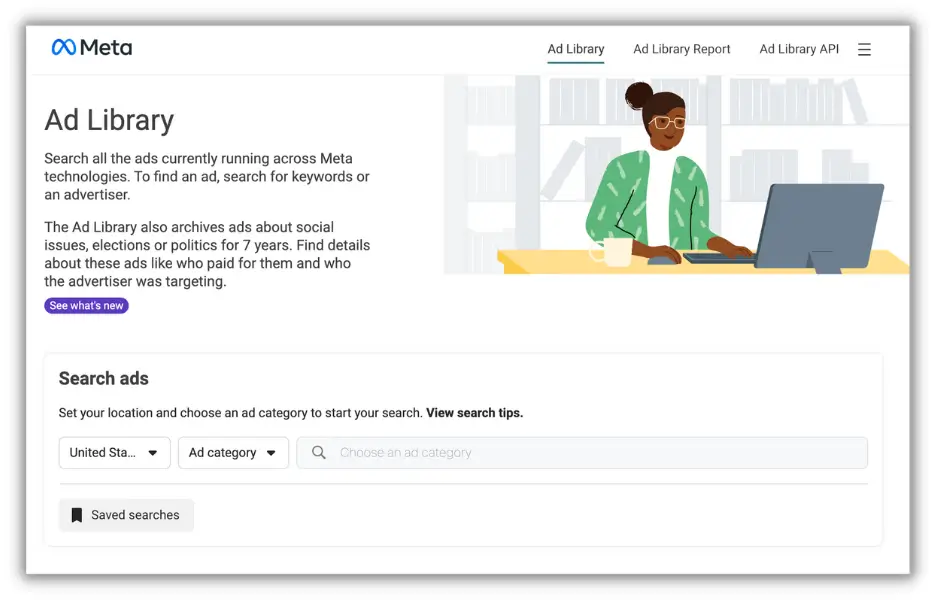
Each entry in the Ad Library contains detailed information about the ad, including creative elements, copy, and the duration of the campaign. By exploring these ads, marketers can identify trends, understand audience targeting, and refine their own advertising approaches. The Facebook Ad Library empowers businesses to stay competitive in the crowded digital landscape by offering insights that can lead to more effective ad campaigns.
Whether you’re a small business owner or part of an established brand, using the Facebook Ad Library is essential. It helps you keep up with market trends and gain an edge over your competitors.
How to Find the Facebook Ad Library?
Finding the Facebook Ad Library is a breeze! This public resource is free and accessible to everyone, regardless of whether you have a Facebook account. Simply visit facebook.com/ads/library to dive right in. You can also type “Facebook Ad Library” into the search bar on your Facebook app for easy access.
While you don’t need to log in to use the Ad Library, logging into Facebook can enhance your experience. By doing so, you can view ads targeted to audiences over 18 and avoid some search limitations. If you’re using an ad blocker, make sure to disable it before searching to ensure smooth access to all features.
Many people underutilize the Facebook Ad Library, missing out on valuable insights. This tool can help you understand what your competitors are doing and which ads are effective. So, whether you’re a marketer, business owner, or just curious, the Ad Library is an invaluable resource that can guide your advertising strategy and keep you informed about industry trends.
How to Use Facebook Ad Library?
With over 10 million active advertisers on Facebook and 93% of marketers regularly using Facebook ads, the Facebook Ad Library is now more crucial than ever. This user-friendly tool has a simple interface and intuitive search options, making it easy to navigate.
1. Choose Your Country and Ad Category
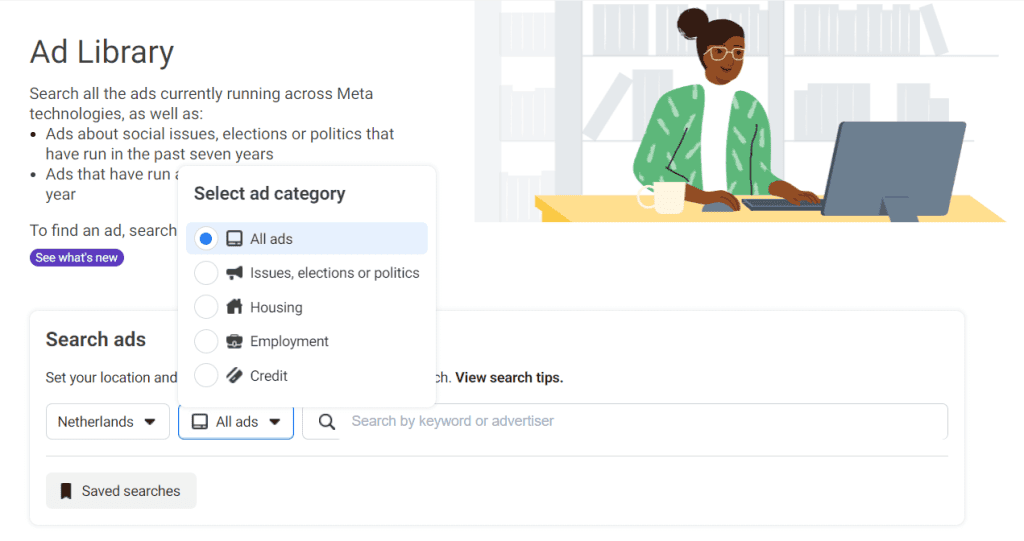
2. Search for a Brand, Keyword or Industry
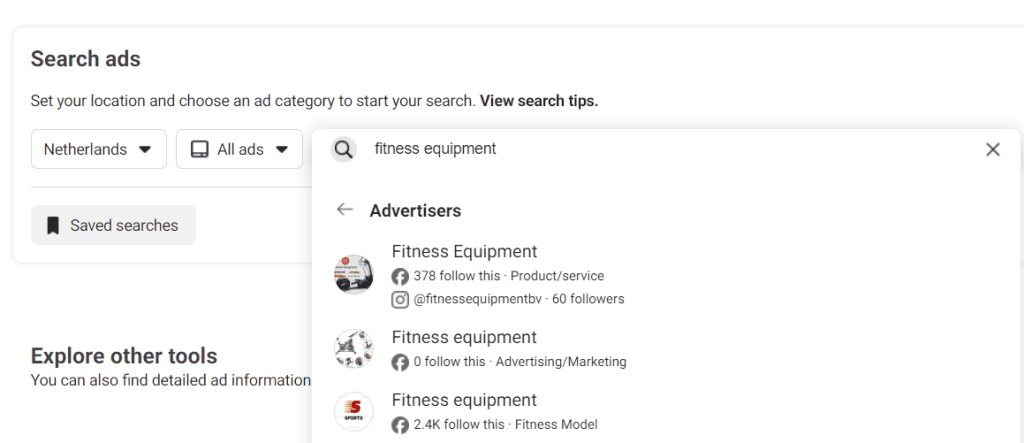
3. Filter Your Search Results
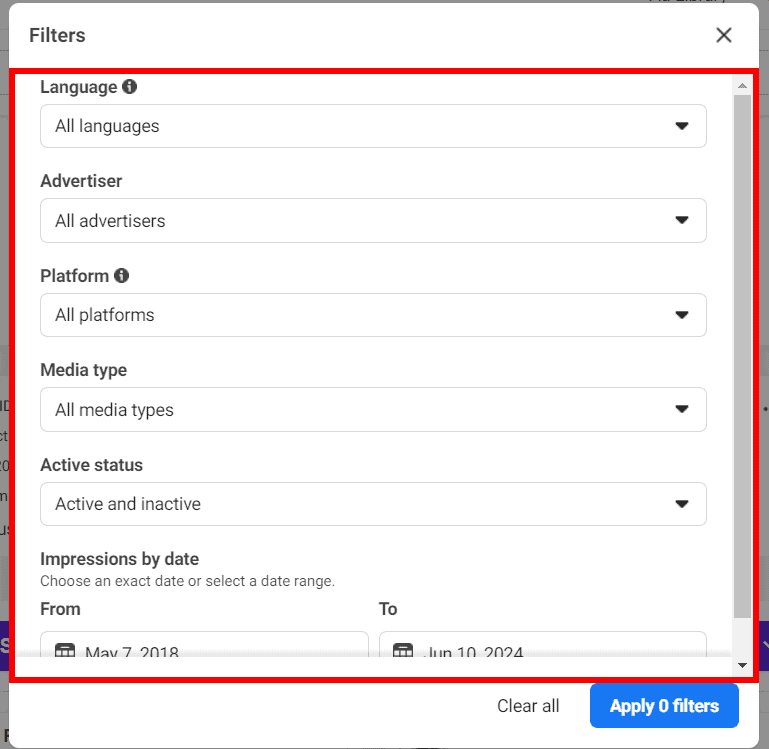
- Languages: Show ads in your selected language.
- Advertiser: Choose specific brands related to your keyword.
- Platform: View ads from Facebook, Instagram, Audience Network, or Messenger.
- Active Status: Decide whether to display all active or inactive ads; focusing on active ads is recommended for the latest trends.
- Impressions by Date: Filter ads based on a specific date range.
Applying these filters will help you create a more targeted list of ads for further analysis.
4. Analyzing Your Findings
After filtering, you might have a significant number of ads to review. Here’s how to make the most of this information:
- Check the Ad’s Running Date: Ads that have been running for longer periods usually indicate success for the advertiser. Note when the ads were launched; if an ad has been active for several months or years, it likely enjoys a higher conversion rate.
- Evaluate the Ad’s Creative and Copy: Analyze the visuals and tone of voice in successful ads. Are they using images, videos, or animations? Understanding these elements can inspire your own ad creatives.
- Identify the Advertiser’s Target Audience: Determine if the ad is remarketing to the same audience or targeting a new demographic. Look for UTM parameters in the URLs to uncover their targeting strategies.
- Review Platforms and Placement Strategy: Check where the ad runs, whether on Facebook, Instagram, Messenger, or Audience Network. This insight reveals how advertisers approach their audience.
5. Gathering Insights from Similar Ads
If a particular competitor’s ad stands out, compare it with their other ads or those from different competitors. Identifying consistent elements can provide valuable insights.
6. Save Ads for Future Reference
To streamline your research process, save ads from the Facebook Ad Library into collections. This allows you to easily track and reference an advertiser’s past ads, making your competitive analysis more efficient.
How Can You Use the Facebook Ad Library to Find Your Competitors’ Ads?
If you want to research your competitors’ Facebook ads, the Facebook Ad Library is the best place to start.
To find out what ads a company is running, follow these simple steps:
- Navigate to the Ad Library: Go to the Facebook Ad Library website.
- Select the Country: Choose the country your competitor is targeting with their ads. This helps you see ads specific to that location.
- Search for the Business Name: Type in the name of the company you want to research. Their ads are usually linked to their Facebook page and share the same name.
Once you do this, you can view all the ads that advertiser has run in the past seven years.
- Explore the Ads: Click on each ad card to see more details. You can also use filters to dig deeper into your competitors’ advertising strategies.
These filters allow you to examine various aspects of their ads, including text, images, and videos. You can also find out which ads they ran during specific holidays or promotional periods.
Why the Facebook Ad Library is Important?
The Facebook Ad Library is a key tool for digital marketing for several reasons: it promotes transparency, helps with competitor analysis, and gives inspiration for ad campaigns. Here’s why this tool is valuable:
Promoting Transparency in Advertising
The Ad Library increases transparency, which is very important in today’s online world. It allows users to look at the ads they see, making advertisers responsible for what they share, especially in political situations. This openness helps stop misleading or harmful ads and ensures that users know who is behind each message, building trust in advertising.
Helping with Competitor Analysis
Marketers can use the Ad Library to watch what their competitors are doing with their ads. By looking at the types of ads competitors run, advertisers can find successful ideas and change their own strategies. Access to this competitive information provides helpful insights into ad spending, targeting methods, and creative ideas, allowing businesses to improve their campaigns and compete better.
Inspiring Creativity
The Ad Library is a great source of ideas for advertisers. It offers many types of ads, including images and videos, so users can explore creative ways to connect with their target audience. This variety helps marketers find new ideas and styles that they can adapt for their own campaigns, making their ads more effective.
Using Simple Filtering Options
The Facebook Ad Library has helpful filtering features that let users sort through data easily. This helps advertisers check ad performance and trends closely. Filters for ad type, active or inactive status, and geographic targeting help users find exactly what they need, making it easier to analyze campaigns.
Understanding Market Trends
By checking the Ad Library regularly, users can keep up with new trends and changes in advertising strategies in their industry. This ongoing review helps advertisers spot new chances, adjust their messages to fit what consumers want, and stay ahead in their marketing efforts.
To Sum up
The Facebook Ad Library, now called the Meta Ad Library, lets you see all active and inactive ads on Facebook and Instagram. This useful tool helps you understand what’s happening in advertising by allowing you to search for brands and filter ads by country and type.
Using the Ad Library, you can find valuable information to boost your own campaigns. In short, it’s a key resource for improving your advertising strategy and staying competitive. Explore it to discover new ideas for your next project!

